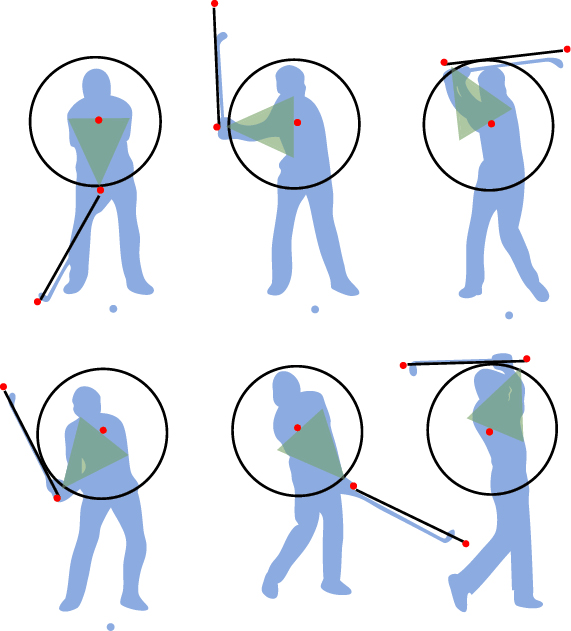Dead Solid Shots
 Often I’ll tell a new student before a lesson, “If I have to talk a lot this is going to be a bad lesson”. I’ll usually get a chuckle or some funny looks. Then I’ll go on to say that listening is the least effective means of learning. Feeling or ‘kinesthetics’ is the best way followed by visual then finally hearing. That is the main problem with communicating through a written article. After conveying a thought or idea it is still up to the reader’s interpretation which may or may not be in line with what the author intended. So it is my aim to give you plenty of visuals in this article through pictures and illustrations. Furthermore words can restrict your swing motion. Hopefully the images will provide you with some concepts, which work much better for learning a new motor skill.
Often I’ll tell a new student before a lesson, “If I have to talk a lot this is going to be a bad lesson”. I’ll usually get a chuckle or some funny looks. Then I’ll go on to say that listening is the least effective means of learning. Feeling or ‘kinesthetics’ is the best way followed by visual then finally hearing. That is the main problem with communicating through a written article. After conveying a thought or idea it is still up to the reader’s interpretation which may or may not be in line with what the author intended. So it is my aim to give you plenty of visuals in this article through pictures and illustrations. Furthermore words can restrict your swing motion. Hopefully the images will provide you with some concepts, which work much better for learning a new motor skill.
 Now it’s time for a little physics lesson. To truly understand, “How to Hit Dead-Solid Shots Everytime’, we need to gain some basic background knowledge of some functions of the golf swing. Firstly, the golf swing is based on a circular motion. If the clubhead travels on a consistent circular path, center contact hits will result. Secondly, all circles have a center point and an outer circumference. The distance from the center to any point on the circumference is the radius. This radius distance stays the same throughout the circle. Now in the golf swing, the circle sits on a base. The base must stay stable. The circle rotates around it’s center and rests on top of the base. This function is closely related to a ferris wheel (illustration, right). The center point on top of the base stays centered in the ferris wheel. It should also stay centered in the golf swing but unfortunately human nature can take over and change it’s height. Obviously if the center point in the golf swing goes up or down you can top the ball or even hit it fat.
Now it’s time for a little physics lesson. To truly understand, “How to Hit Dead-Solid Shots Everytime’, we need to gain some basic background knowledge of some functions of the golf swing. Firstly, the golf swing is based on a circular motion. If the clubhead travels on a consistent circular path, center contact hits will result. Secondly, all circles have a center point and an outer circumference. The distance from the center to any point on the circumference is the radius. This radius distance stays the same throughout the circle. Now in the golf swing, the circle sits on a base. The base must stay stable. The circle rotates around it’s center and rests on top of the base. This function is closely related to a ferris wheel (illustration, right). The center point on top of the base stays centered in the ferris wheel. It should also stay centered in the golf swing but unfortunately human nature can take over and change it’s height. Obviously if the center point in the golf swing goes up or down you can top the ball or even hit it fat.
 Try This Drill – Place a golf club over your back and bend forward from the waist. Slightly bend from your knees. While looking in a mirror, turn back and through like a golf swing and make sure your head does not go up or down. There are three areas in which you can go up or down with your base/body: 1.) Feet 2.) Knees 3.) Waist. Try to keep each of these level throughout the motion.
Try This Drill – Place a golf club over your back and bend forward from the waist. Slightly bend from your knees. While looking in a mirror, turn back and through like a golf swing and make sure your head does not go up or down. There are three areas in which you can go up or down with your base/body: 1.) Feet 2.) Knees 3.) Waist. Try to keep each of these level throughout the motion.
 If that was all there was to it golf would be simple. Unfortunately there is a few more pieces to get the whole golf swing mechanism performing properly. Unlike the ferris wheel, in the golf swing there is a lever attached to the outside of the circle that whips the club through. This lever is operated via the wrists. Without this lever or whip the golf ball would only travel about 40% of it’s potential distance. It works quite like a hammering motion (hammer illustration, right).
If that was all there was to it golf would be simple. Unfortunately there is a few more pieces to get the whole golf swing mechanism performing properly. Unlike the ferris wheel, in the golf swing there is a lever attached to the outside of the circle that whips the club through. This lever is operated via the wrists. Without this lever or whip the golf ball would only travel about 40% of it’s potential distance. It works quite like a hammering motion (hammer illustration, right).
If this lever system does not work in the golf swing not only will you lose power your arms will fold in the backswing shortening your swing radius.
Try This Drill – Here is a drill to get the wrists hinging and keep the radius in the golf swing. Place two shafts just inside your ball-target-line but parallel to it. Next place a tee into the butt-end of a mid-iron. Begin making half swings with your arms only going from hip high to hip high (9 o’clock to 3 o’clock). As you swing back, hinge your wrists enough to get the tee to point at the shaft along the ground on the back swing and the other shaft on the through swing. This drill will also promote a proper swing plane and increase your distance.
Now we have an equation that equals the whole swing motion. First, we established a base that is stabilized. The base top also holds the center. A circle rotates off of this center. Finally, a lever system whips off of the circle. All this added together equals the golf swing. Sounds confusing, right? Again, it’s using words that makes it harder to understand. Look at the illustration below. A image is worth a thousand words…
Simply put, if you hit off center shots, you either; a.) Moved your center causing the club to come up or not to bottom out at the ball or, b.) You changed the length of your radius by shortening your arms. (Remember you have to hinge your wrists to keep the radius from breaking down).
Just having a clear image in your head of these concepts during practice can help you tremendously with your golf swing. If you undertand the function of the golf swing and can visualize it, you can go about correcting your motion yourself. My goal with every student is to make them great instructors themselves. Afterall, you cannot call an (800) number on hole 15 of a golf round for help. You need to have some basic ideas and understandings of how things should work should they go wrong. Finally on the following page we put the whole thing together in a swing sequence of a golfer. It is such a good visual we’re using the whole page to display it.
In the golf swing, the center of the circle is the chest and the outer circumference is the hands or butt-end of the grip.
(Swing Sequence)
